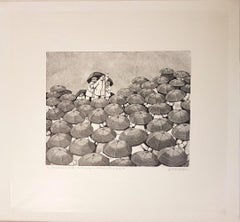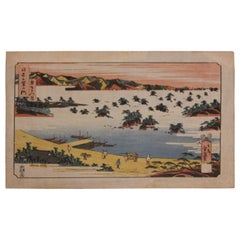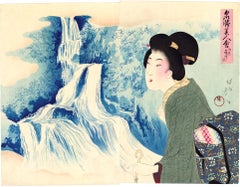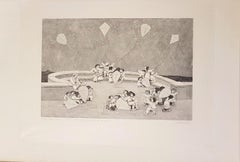Alberico Morena Art
to
2
2
2
1
1
Overall Height
to
Overall Width
to
1
2
1
1
2
6,934
3,279
2,514
1,213
2
Artist: Alberico Morena
The Orator - Original Woodcut by Alberico Morena - 1971
By Alberico Morena
Located in Roma, IT
Image dimensions: 24 x 29.5 cm.
Beautiful xilograph hand-printed on tissue-paper, 1971. Print representing a political public speech. Hand-signed with pencil on lower-right margin. ...
Category
1970s Alberico Morena Art
Materials
Woodcut
The Garden - Original Woodcut by Alberico Morena - 1958
By Alberico Morena
Located in Roma, IT
Image dimensions: 28 x 33 cm.
Fine xilograph hand-printed on tissue-paper, representing a garden. Hand-signed with pencil on lower-right margin. Signed on plate too, lower-right cor...
Category
1950s Alberico Morena Art
Materials
Woodcut
Related Items
Edo Landscape Japanese Woodblock Print
By Utagawa Hiroshige (Ando Hiroshige)
Located in Houston, TX
Edo Meisho woodblock print of a famous Japanese coastal dock. This woodblock is most likely apart of the series "One Hundred Famous Views of Edo." The woodblock print is printed on r...
Category
1850s Edo Alberico Morena Art
Materials
Woodcut
H 10 in W 15 in D 0.004 in
Japanese Beauty Admiring Kirifuri Waterfall
By Yoshu Chikanobu
Located in Burbank, CA
A beauty turns to admire the Kirifuri Waterfall in Nikko Province. She holds the handle of an umbrella and wears fashionable clothing that is beautifully printed. This series pairs f...
Category
1890s Edo Alberico Morena Art
Materials
Mulberry Paper, Handmade Paper, Woodcut
Jonah
By Sadao Watanabe
Located in Santa Monica, CA
SADAO WATANABE (Japanese 1913-1996)
JONAH, 1959
Color stencil, signed, numbered and dated in white ink. Sheet, 25 5/8 x 22 5/8 inches. Edition: 44/50. Good color and generally good ...
Category
1950s Modern Alberico Morena Art
Materials
Stencil, Woodcut
"Various Himochi" Wagashi Festival Japanese Woodblock Print by Utagawa Toyokuni
Located in Soquel, CA
"Various Himochi" Wagashi Festival Japanese Woodblock Print by Utagawa Toyokuni
Rare oversized early 19th century 5-tiered woodblock by Utagawa Ichiyosai Toyokuni, (Japan, 1769-1825), a Japanese lord and wife oversee a sekku festival of food, music, and dolls or toys. '"oshi" is the first day of “Mi (Snake)” in the third month of the lunar calendar. This day, known in modern Japan as the Girls' Festival, originated in China as a form of purification ceremony in which water and drinking peach blossom wine were used to drive away evil. Many kinds of hishi-mochi appear in this picture of hina ningyo (dolls associated with Hinamatsuri, or the Girl’s Day) from Omochae.
The custom of eating special dishes at events throughout the year and at milestones in people's lives has existed since ancient times. This paragraph specifically focuses on the annual event called sekku, and life events that involve eating sweets. Joshi is the first day of “Mi (Snake)” in the third month of the lunar calendar. This day, known in modern Japan as the Girls' Festival, originated in China as a form of purification ceremony in which water and drinking peach blossom wine were used to drive away evil. According to the Keiso saijiki, in ancient China, on the third day of the third lunar month, people ate “ryuzetsuhan,” which is the juice of gogyo (Jersey cudweed) mixed with rice flour and nectar. In Japan, there is a record in the Heian period history book Nihon Montoku tenno jitsuroku [839-5] that it was an annual event to make kusamochi using gogyo on the third day of the third month of the lunar calendar, which may have been influenced by Chinese customs.
The tradition of eating kusamochi on the third day of the third month of the lunar calendar continued after that. By the Edo period, however, hishimochi had come to be used as a sweet to serve on the third day of the third month. A picture of a hishimochi is included in the Morisada manko , which we mentioned in Part 1. According to it, hishimochi in the Edo period were often three layers of green-white-green instead of the now common red-white-green. However, it is possible to see from our collection that not all hishimochi were made in this way. Omochae published in 1857, is a good example. Omochae is a type of ukiyoe print...
Category
1820s Edo Alberico Morena Art
Materials
Ink, Rice Paper, Woodcut
H 26.75 in W 21.75 in D 0.25 in
3 Panel Hand Colored Japanese Woodcut Print Lithograph
By Keisai Eisen
Located in Soquel, CA
3 Panel Hand Colored Japanese Woodcut Print Lithograph
Three panel hand colored woodcut lithograph from Nanso Satomi hakkenden, Tale of the Eight Dogs...
Category
Early 19th Century Edo Alberico Morena Art
Materials
Paper, Ink, Woodcut
Beauties on the Beach with view of Mount Fuji
By Yoshu Chikanobu
Located in Burbank, CA
Shichirigahama, Sagami Province. A beauty in the foreground waves to her young companions, who run towards her on the beach. The beauty at left wears a western-style golden ring. We ...
Category
1890s Edo Alberico Morena Art
Materials
Mulberry Paper, Handmade Paper, Woodcut
Zwei Frauen (Two Women) /// German Expressionism Karl Schmidt-Rottluff Woodcut
By Karl Schmidt-Rottluff
Located in Saint Augustine, FL
Artist: Karl Schmidt-Rottluff (German, 1884-1976)
Title: "Zwei Frauen (Two Women)"
Portfolio: Das Spiel Christa vom Schmerz der Schönheit des Weibes (The Play Christa from the Pain o...
Category
1910s Expressionist Alberico Morena Art
Materials
Engraving, Woodcut
Blue Face from the Brushstroke Figures Series
By Roy Lichtenstein
Located in Miami, FL
Lithograph, waxtype woodcut and screenprint on 638-g/m cold-pressed Saunders Waterford Paper. From the "Brushstroke Figures" series, 1989. Hand signed rf Lichtenstein, dated ('89) a...
Category
1980s Contemporary Alberico Morena Art
Materials
Lithograph, Screen, Woodcut
Free Shipping
H 53.7 in W 38.9 in
Modern American Industrial Landscape
Located in Buffalo, NY
An original woodblock print dated 1965, titled "Our Town" but signed illegibly.
Category
1960s American Modern Alberico Morena Art
Materials
Woodcut, Paper
Rare 1923 Cubist Reuven Rubin Woodcut Woodblock Kabbalah Print Israeli Judaica
By Reuven Rubin
Located in Surfside, FL
This is from the original first edition 1923 printing. there was a much later edition done after these originals.
These are individually hand signed in pencil by artist as issued.
This listing is for the one print. the other documentation is included here for provenance and is not included in this listing.
The various images inspired by the Jewish Mysticism and rabbis and mystics of jerusalem and Kabbalah is holy, dramatic and optimistic Rubin succeeded to evoke the spirit of life in Israel in those early days.
They are done in a modern art style influenced by German Expressionism, particularly, Ernst Barlach, Ernst Ludwig Kirchner, and Franz Marc, as introduced to Israel by Jakob Steinhardt, Hermann Struck and Joseph Budko.
Reuven Rubin 1893 -1974 was a Romanian-born Israeli painter and Israel's first ambassador to Romania.
Rubin Zelicovich (later Reuven Rubin) was born in Galati to a poor Romanian Jewish Hasidic family. He was the eighth of 13 children. In 1912, he left for Ottoman-ruled Palestine to study art at Bezalel Academy of Art and Design in Jerusalem. Finding himself at odds with the artistic views of the Academy's teachers, he left for Paris, France, in 1913 to pursue his studies at the École Nationale Supérieure des Beaux-Arts. He was of the well known Jewish artists in Paris along with Marc Chagall and Chaim Soutine,
At the outbreak of World War I, he was returned to Romania, where he spent the war years.
In 1921, he traveled to the United States with his friend and fellow artist, Arthur Kolnik. In New York City, the two met artist Alfred Stieglitz, who was instrumental in organizing their first American show at the Anderson Gallery. Following the exhibition, in 1922, they both returned to Europe. In 1923, Rubin emigrated to Mandate Palestine.
Rubin met his wife, Esther, in 1928, aboard a passenger ship to Palestine on his return from a show in New York. She was a Bronx girl who had won a trip to Palestine in a Young Judaea competition. He died in 1974.
Part of the early generation of artists in Israel, Joseph Zaritsky, Arieh Lubin, Reuven Rubin, Sionah Tagger, Pinchas Litvinovsky, Mordecai Ardon, Yitzhak Katz, and Baruch Agadati; These painters depicted the country’s landscapes in the 1920s rebelled against the Bezalel school of Boris Schatz. They sought current styles in Europe that would help portray their own country’s landscape, in keeping with the spirit of the time. Rubin’s Cezannesque landscapes from the 1920s were defined by both a modern and a naive style, portraying the landscape and inhabitants of Israel in a sensitive fashion. His landscape paintings in particular paid special detail to a spiritual, translucent light. His early work bore the influences of Futurism, Vorticism, Cubism and Surrealism.
In Palestine, he became one of the founders of the new Eretz-Yisrael style. Recurring themes in his work were the bible, the prophet, the biblical landscape, folklore and folk art, people, including Yemenite, Hasidic Jews and Arabs. Many of his paintings are sun-bathed depictions of Jerusalem and the Galilee. Rubin might have been influenced by the work of Henri Rousseau whose naice style combined with Eastern nuances, as well as with the neo-Byzantine art to which Rubin had been exposed in his native Romania. In accordance with his integrative style, he signed his works with his first name in Hebrew and his surname in Roman letters.
In 1924, he was the first artist to hold a solo exhibition at the Tower of David, in Jerusalem (later exhibited in Tel Aviv at Gymnasia Herzliya). That year he was elected chairman of the Association of Painters and Sculptors of Palestine. From the 1930s onwards, Rubin designed backdrops for Habima Theater, the Ohel Theater and other theaters.
His biography, published in 1969, is titled My Life - My Art. He died in Tel Aviv in October 1974, after having bequeathed his home on 14 Bialik Street and a core collection of his paintings to the city of Tel Aviv. The Rubin Museum opened in 1983. The director and curator of the museum is his daughter-in-law, Carmela Rubin. Rubin's paintings are now increasingly sought after. At a Sotheby's auction in New York in 2007, his work accounted for six of the ten top lots. Along with Yaacov Agam and Menashe Kadishman he is among Israel's best known artists internationally. Education
1912 Bezalel Academy of Arts and Design, Jerusalem
1913-14 École des Beaux Arts, Paris and Académie Colarossi, Paris
Select Group Exhibitions
Eged - Palestine Painters Group Eged - Palestine Painters Group, Allenby Street, Tel Aviv 1929
Artists: Chana Orloff, Abraham Melnikoff, Rubin, Reuven Nahum Gutman, Sionah Tagger,Arieh Allweil,
Jewish Artists Association, Levant Fair, Tel Aviv, 1929
Artists: Ludwig Blum,Eliyahu Sigad, Shmuel Ovadyahu, Itzhak Frenel Frenkel,Ozer Shabat, Menahem Shemi...
Category
1920s Abstract Alberico Morena Art
Materials
Woodcut
Wedding Party
Located in Buffalo, NY
An original mid century modern woodblock print.
This work is hand signed illegibly and titled "Wedding Party".
Category
1960s Modern Alberico Morena Art
Materials
Paper, Woodcut
Lord on the Sand Castle - XX century Black & White Woodcut Print
By Franciszek Bunsch
Located in Warsaw, PL
Illustration for Jules de la Medelen's "Lord on the Sand Castle" ("Le Marquis Des Saffras")
FRANCISZEK BUNSCH (born in 1926) Franciszek Bunsch was born in Bielsko in 1926. He studie...
Category
1950s Contemporary Alberico Morena Art
Materials
Paper, Woodcut
Previously Available Items
The Kites - Original Woodcut by Alberico Morena - 1960s
By Alberico Morena
Located in Roma, IT
Image dimensions: 26 x 40 cm.
Beautiful xilograph hand-printed on tissue-paper. Print representing some children playing with kites. Hand-signed with pencil on lower-right margin. T...
Category
1960s Alberico Morena Art
Materials
Woodcut
H 15.36 in W 20.48 in D 0.08 in
Alberico Morena art for sale on 1stDibs.
Find a wide variety of authentic Alberico Morena art available for sale on 1stDibs. You can also browse by medium to find art by Alberico Morena in woodcut print and more. Not every interior allows for large Alberico Morena art, so small editions measuring 18 inches across are available. Customers who are interested in this artist might also find the work of Ossi Czinner, Renzo Biasion, and Mario Logli. Alberico Morena art prices can differ depending upon medium, time period and other attributes. On 1stDibs, the price for these items starts at $312 and tops out at $321, while the average work can sell for $316.




